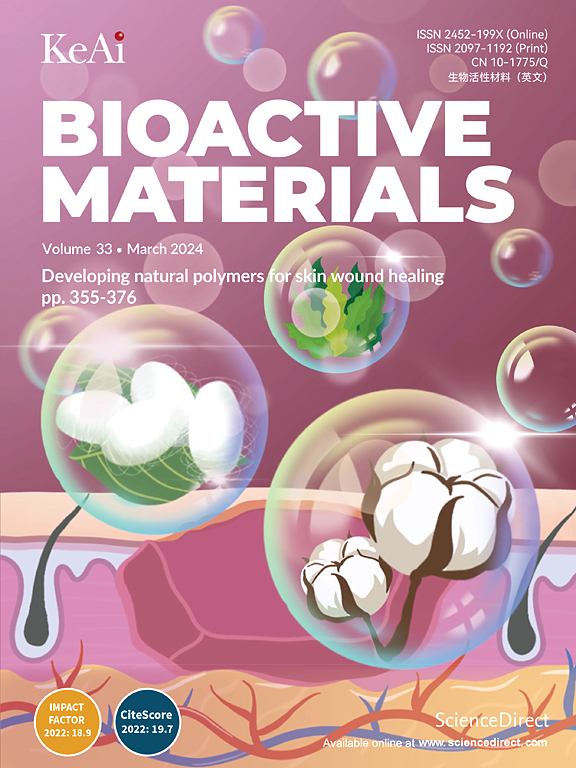Advanced biomaterials for targeting mature biofilms in periodontitis therapy
IF 18
1区 医学
Q1 ENGINEERING, BIOMEDICAL
引用次数: 0
Abstract
Periodontitis is a chronic inflammatory disease primarily caused by bacteria, leading to inflamed and bleeding gums, periodontal pocket formation, and bone loss. Affecting 70%–90% of adults over 65, periodontitis is a leading cause of tooth loss and significantly impacts quality of life. Standard treatments, including subgingival scraping and antibiotics, have limitations, and antibiotic resistance among periodontal pathogens is an increasing concern. Biofilms are barriers to drugs and immune responses, contributing to bacterial resistance and reducing antibiotic effectiveness. Due to their adjustable physicochemical properties, bioactive materials potentially eliminate bacterial biofilms, presenting a promising alternative for periodontitis therapy. In this review, the recent innovations in biomaterials for removing mature biofilms in periodontitis are examined, and their broader potential is discussed. Additionally, the compositions of bacterial biofilms, formation pathways, and intrinsic drug resistance mechanisms are discussed. Finally, the strategies for optimizing subgingival biofilm removal in periodontitis are highlighted, such as targeting biofilms-embedded bacteria, disrupting the extracellular polymeric substances, and utilizing combined approaches. A comprehensive understanding of the properties of biomaterials guides the rational design of highly targeted and effective therapies for periodontitis.

成熟生物膜靶向治疗牙周炎的先进生物材料
牙周炎是一种慢性炎症性疾病,主要由细菌引起,导致牙龈发炎和出血,牙周袋形成和骨质流失。影响70%-90%的65岁以上成年人,牙周炎是导致牙齿脱落的主要原因,严重影响生活质量。标准治疗,包括龈下刮痧和抗生素,有局限性,牙周病原体的抗生素耐药性日益受到关注。生物膜是药物和免疫反应的屏障,有助于细菌耐药性和降低抗生素的有效性。由于其可调节的物理化学性质,生物活性材料有可能消除细菌生物膜,为牙周炎治疗提供了一个有希望的替代方案。本文综述了近年来用于去除牙周炎成熟生物膜的生物材料的研究进展,并对其应用前景进行了展望。此外,还讨论了细菌生物膜的组成、形成途径和内在耐药机制。最后,强调了优化牙周炎龈下生物膜去除的策略,如靶向生物膜嵌入细菌,破坏细胞外聚合物物质,以及采用联合方法。全面了解生物材料的特性可以指导合理设计高度靶向和有效的牙周炎治疗方法。
本文章由计算机程序翻译,如有差异,请以英文原文为准。
求助全文
约1分钟内获得全文
求助全文
来源期刊

Bioactive Materials
Biochemistry, Genetics and Molecular Biology-Biotechnology
CiteScore
28.00
自引率
6.30%
发文量
436
审稿时长
20 days
期刊介绍:
Bioactive Materials is a peer-reviewed research publication that focuses on advancements in bioactive materials. The journal accepts research papers, reviews, and rapid communications in the field of next-generation biomaterials that interact with cells, tissues, and organs in various living organisms.
The primary goal of Bioactive Materials is to promote the science and engineering of biomaterials that exhibit adaptiveness to the biological environment. These materials are specifically designed to stimulate or direct appropriate cell and tissue responses or regulate interactions with microorganisms.
The journal covers a wide range of bioactive materials, including those that are engineered or designed in terms of their physical form (e.g. particulate, fiber), topology (e.g. porosity, surface roughness), or dimensions (ranging from macro to nano-scales). Contributions are sought from the following categories of bioactive materials:
Bioactive metals and alloys
Bioactive inorganics: ceramics, glasses, and carbon-based materials
Bioactive polymers and gels
Bioactive materials derived from natural sources
Bioactive composites
These materials find applications in human and veterinary medicine, such as implants, tissue engineering scaffolds, cell/drug/gene carriers, as well as imaging and sensing devices.
 求助内容:
求助内容: 应助结果提醒方式:
应助结果提醒方式:


